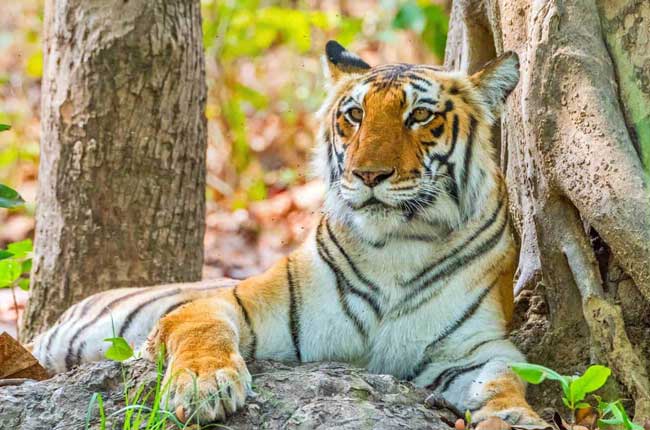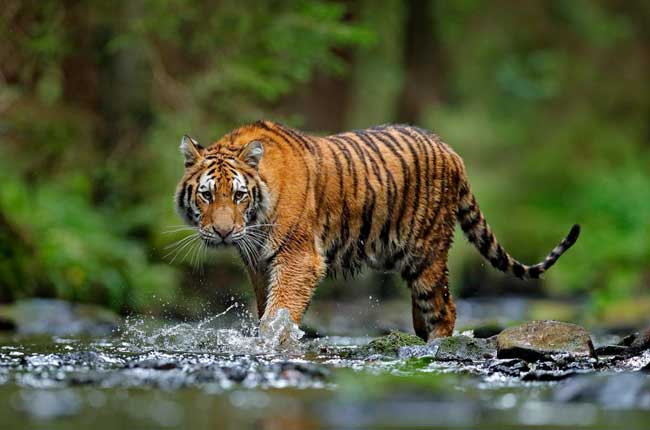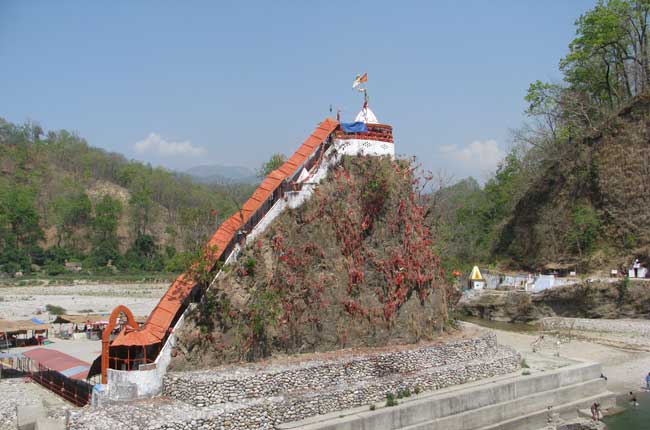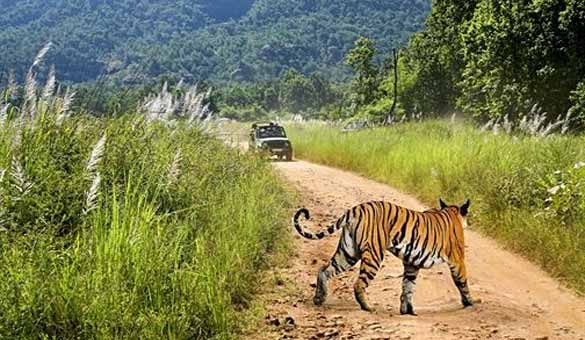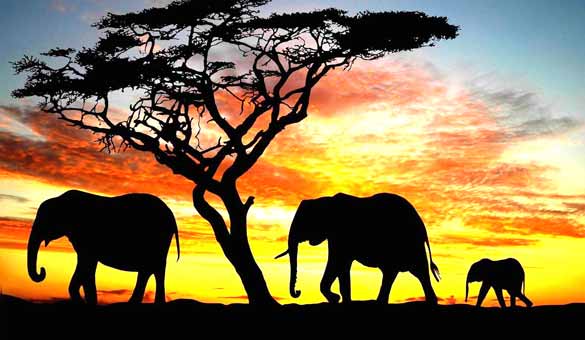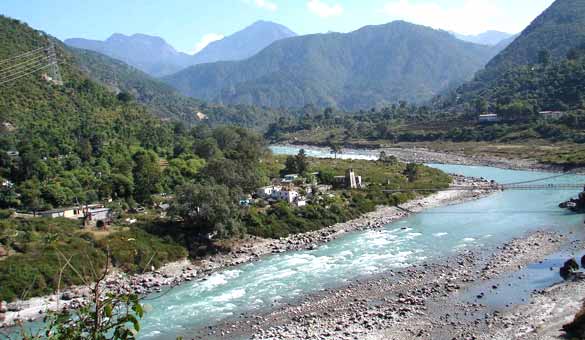| Flora & Fauna |
FLORA
The different habitat types of Corbett i.e. mountains, sal forests, chaurs, khair-sissoo forests, and rivers have their distinct assemblage of plants. More than 600 species of trees, shrubs, herbs, bamboos, grasses, climbers and ferns have been identified in the Park.
Trees
The most visible trees found in Corbett are sal, khair and sissoo (see Habitats and Ecosystems). Many other species that contribute to the diversity, are found scattered throughout the park.
Chir pine (Pinus roxburghi)
is the only conifer of the Park and is found on ridge-tops like Chir Choti but comes quite low in Gajar Sot. The upper reaches near Kanda have Banj Oak (Quercus leucotrichophora) growing which is essentially a Himalayan species.
Palms
include Khajur or Date-palm (Phoenix sp.) that occurs in open areas. Wallachia densiflora is a rare palm characteristic of Eastern Himalayas but is found in Corbett near Sultan.
Flowering trees
lend colour to the forests in Corbett. The main ones are Kachnaar (Bauhinia variegata) with pink to white flowers, Semal (Bombax ceiba) with big red blooms, Dhak or Flame-of-the-forest (Butea monosperma) with bright orange flowers, Madaar or Indian Coral (Erythrinia indica) with scarlet red flowers and Amaltas (Cassia fistula) with bright yellow chandelier like blooms.
Some species of trees that do not occur naturally in the Park have been artificially planted in and around habitation. These include Teak (Tectona grandis), Eucalyptus, Jacaranda (Jacaranda mimosaefolia), Silver Oak (Gravillea robusta) and Bottlebrush (Callistemon viminalis), and can be seen in and around forest rest houses.
Shrubs
Flowers of HelicterisShrubs dominate the tree understorey and scrub areas. There are several species of Ber (Zizyphus sp.) in open areas and provide food and habitat to many birds and animals. Maror phali (Helicteres isora) is an easily noticeable shrub. Its fruits are in the form of twisted spiralling pods. Karaunda (Carissa sp.), with pinkish-white flowers and sour fruit, is found under sal. Hisar (Rubus ellipticus) has yellow, juicy, mulberry-like fruits that are savoured by animals.
Jhau (Tamarix dioica) is found along the Ramganga basin on sandy or rocky soil. Colebrookia oppsitifolia and Adhatoda vasica are found in nallahs.
Bamboo
In some parts of Corbett the vegetation is dominated by bamboo forest. The main species is Male Bamboo (Dendrocalamus strictus) having clustered stout stems and shining papery stem sheaths.
Bamboos follow a peculiar flowering process. All bamboos in a forest flower together at the same time once in several decades. After flowering, fruiting and dispersal of seeds, all individuals die together.
Herbs
Herbs include many species of wildflowers belonging mostly to Pea and Aster families. They are most visible on grasslands or chaurs and on open areas.
Drymaria diandra is a spreading annual herb with heart shaped leaves and occurs in moist shady places. Bhilmora (Rumex hastatus) is a sour tasting herb used for making chutney. Other species encountered in Corbett are Euphorbia hirta, a hairy herb, Indigofera liniofolia with bright red flowers, Clover (Oxalis sp.) with three leaflets, Solanum sp. and Leonotis nepatafolia (orange flowers and spiky round fruits).
Grasses
Corbett has over 70 grass speciesGrasses form the largest group of plant species in Corbett with more than 70 species recorded. They occupy different habitats, especially chauINR
They include Kansi (Saccharum sp.), Themeda arundinacea, Baib or Bhabar (Eulaliopsis binata), Narkul (Arundo donax), Tiger Grass (Thysanolaena maxima), Khus Khus (Vetiveria zizanioides), Cymbopogon flexuosus (a tufted grass with pleasant aromatic leaves), Aristida cyanantha (found amidst boulders), Neyraudia arundinacea (with light brown inflorescence) and Heteropagon contortus (Spear Grass with conspicuous sharp blades that adhere to clothes and penetrates skin).
Woody climbers
Woody climbers found in the park are Milletia auriculata, Crypotepris buchanani, Porana paniculata (dense canopy with profuse white flowers), Clematis gouriana (shrubby twiner with tendril like branches) and Bauhinia vahlii (flat rusty hairy pods, large leaves used for making pattal)
Epiphytes and orchids
Epiphytes are plants that grow above the ground on other plants, and derive nutrients and water from rain, the air, dust, etc. They are found on sal and other trees in the park.
They include Dendrophthoe falcata (scarlet red flowers), Scurrula cordifolia (hairy coating on shoots and leaves), Vanda testacea (orchid with flat keeled leaves and beautiful spike flowers), Cuscuta reflexa (or ‘Dodder’, with interlaced yellow cord like habit, growing on shrubs).
Fauna
Tiger
Corbett has one of the highest densities of tigeINR The tiger (Panthera tigris) is perhaps the most celebrated of the wild animals of India. It is symbolises the power of Nature and finds an important place in our culture, mythology and legends. It has been worshiped as the guardian and ruler of the forest.
Tigers are believed to have evolved in East Asia (China) about 2 million years ago. They then dispersed to other parts of Asia. There existed eight subspecies of tiger, out of which three have gone extinct. Today this perfect carnivore is a critically endangered species, though once it roamed freely in most of Asia. India is home to the largest population of wild tigers in the world. There are estimated to be only 5000 to 7500 tigers surviving in the world. Out of these, the subspecies found in the Indian subcontinent, the Bengal tiger has 3000 to 4500 surviving members, more than three-fourths of which are in India.
The Asian Elephant
The elephant, largest of the land mammals, has been an integral part of the history, mythology, tradition, culture and religion of India. There are three surviving species of elephants in the world, one in Asia and two in Africa. The Asian elephant (Elephas maximus) is distributed in the Indian subcontinent and Southeast Asia. Unlike the African species, Asian elephants have been domesticated for thousands of years and have been used in medieval warfare, for temples, and as a working animal.
A herd of wild elephants in a chaurThe Asian elephant was once found throughout south and southeast Asia but now it has been reduced to several scattered populations because of human activities like conversion of forest areas to farming, construction of dams and civil works like roads and canals. Apart from habitat constriction, these wide-ranging animals also face obstruction of their traditional migration routes. Poaching of elephants for ivory is another serious problem that elephants face.
Corbett Tiger Reserve has about 700 Asian elephants. They are part of the migratory population that also lives in Rajaji National Park. Earlier, there were much fewer elephants in Corbett but their population in the park has increased significantly in recent decades. Although, present throughout the Park, elephants are most easily sighted in Dhikala chaur, Phulai chaur, and near the Saddle Dam.
Deer
Corbett has four species of deer. They are the most frequently sighted large mammals in the Park. Chital, the commonest deer of CorbettChital (Axis axis) or Spotted deer is the commonest of deer species of Corbett. It is also the most beautiful, with characteristic white spots on its reddish-brown body. Only male chital have antlers that may grow up to 1 m length. These antlers are periodically shed and a new set developed every time.
Other mammals
The Leopard (Panthera pardus) is the other large cat found in Corbett. Compared to the tiger leopards are smaller, more graceful and have a long agile body that has rosettes instead of stripes. It also has the ability to limb trees. Leopards are quite versatile, adaptable to a variety of terrains as well as to a broad range of prey that includes everything from insects and rodents up to large ungulates. Leopards mostly hunt during twilight hours and at night. They also ambush their prey by jumping down from trees.

